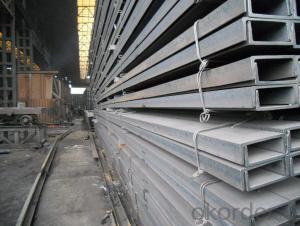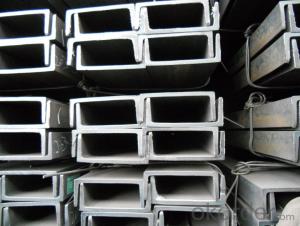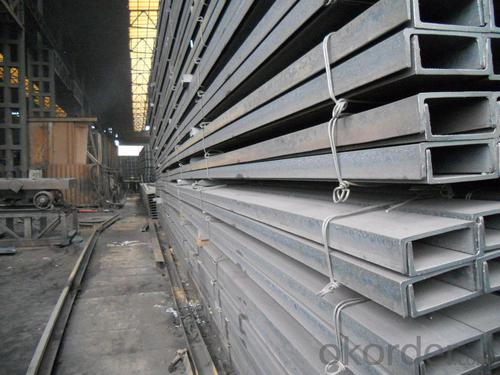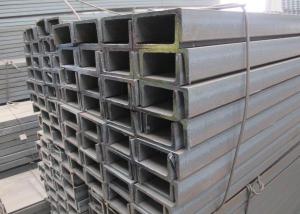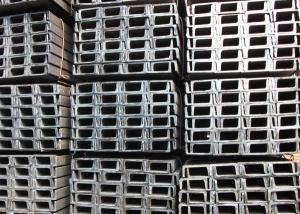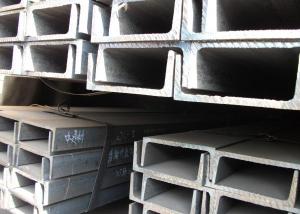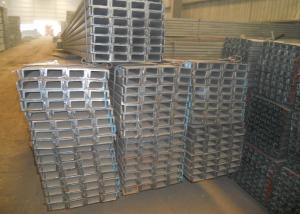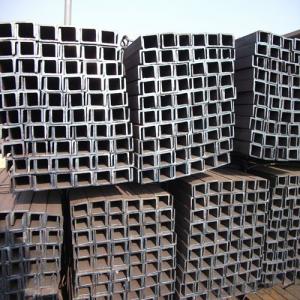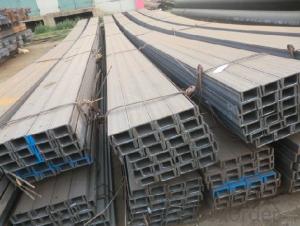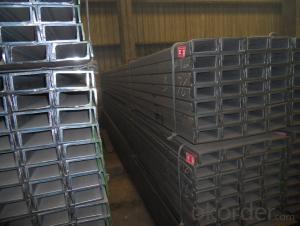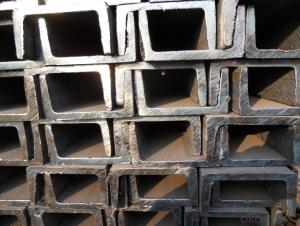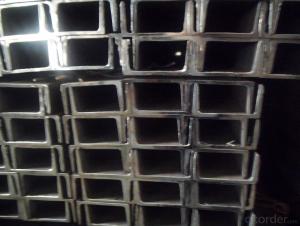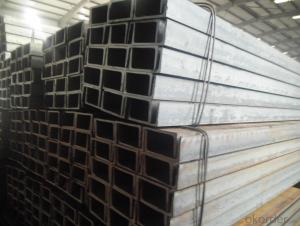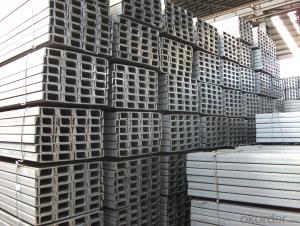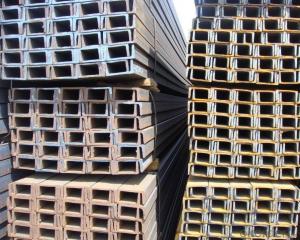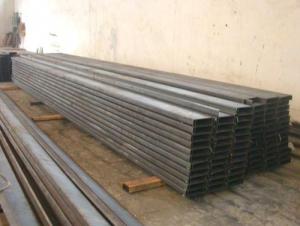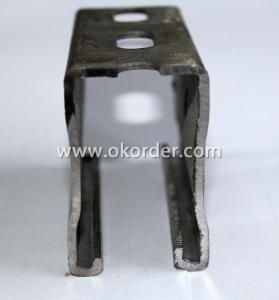EN Standard Hot Rolled Steel U Channels for Constrction UPN,UPE
- Loading Port:
- Tianjin
- Payment Terms:
- TT OR LC
- Min Order Qty:
- 25 m.t.
- Supply Capability:
- 200000 m.t./month
OKorder Service Pledge
OKorder Financial Service
You Might Also Like
Specifications of EN Standard Hot Rolled Steel U Channels for Constrction UPN,UPE:
1.Our UPN Channel Steel has lots of advantages, just as followings:
a) At reasonable price and good quality.
b) To be convenient in construction and to save much time and labor.
c) The length of UPN can be manufactured according to customer’s requirements.
d) The UPN Channel Steel has strong mechanical strength.
e). The UPN Channel Steel possesses various kind of fittings, through which it is suitbal for many combinations.
f) Our UPN Channel Steel is attractive in appearance as well as beautiful in design
g) Free from slotted punching
2. The detailed sections of our UPN Channel Steel can be found in table-1
UPN U CHANNEL | Standard h | Sectional b | Dimension s | t | Mass: Kg/m |
(mm) | (mm) | (mm) | (mm) | ||
80x45 | 80 | 45 | 6.0 | 8.0 | 8.64 |
100X50 | 100 | 50 | 6.0 | 8.5 | 10.6 |
120x55 | 120 | 55 | 7.0 | 9.0 | 13.4 |
140x60 | 140 | 50 | 7.0 | 10.0 | 16.0 |
160x65 | 160 | 65 | 7.5 | 10.0 | 18.8 |
180x70 | 180 | 70 | 8.0 | 11.0 | 22.0 |
Table-1
Note: we are definitely good at manufacturing and supplying UPN channel steel as per S235JR. Also, we are willing and able to provide our customers UPN channel steel in other sizes, which depends on customers’ concret requirements for the quantity.
3. The chemical composition of UPN Channel Steel as per S235JR is shown in the table-2
Alloy No | Element(%) | ||||
C | Mn | S | P | Si | |
S235JR | 0.12—0.20 | 0.3—0.7 | ≤0.030 | ≤0.030 | ≤0.20 |
Table-2
4. The mechanical property of UPN Channel Steel as per S235JR is shown in the table-3-1 and table-3-2
Alloy No | Yielding strength point( Mpa) | |||
Thickness (mm) | ||||
≤16 | >16--40 | >40--60 | >60--100 | |
≥ | ||||
S235JR | 235 | 225 | 215 | 195 |
Table-3-1
Alloy No | Tensile strength (Mpa) | Elongation after fracture(%) | |||
Thickness (mm) | |||||
≤16 | >16--40 | >40--60 | >60--100 | ||
≥ | |||||
S235JR | 340--510 | 24 | 23 | 22 | 27 |
Table-3-2
Applications of EN Standard Hot Rolled Steel U Channels for Constrction UPN,UPE:
The UPN Channel Steel can be applied to construction of warehouses, workshops, sport stadiums and car parks etc.The hot rolled channel steel belongs to carbon structural steel which is applied to in the field of construction and machinery.In details, the hot rolled channel steel is usually used for arch-itechtural structure, and they could be welded in order to support or hang a vari-ety of facilities. They are also usually used in combination with I beam. Generally,the hot rolled channel steel we supply must possess perfect welding property, riveting property and mechanical property and so on.
- Q: Which kind of wind resistance is better for square tube, square tube or channel steel?
- Square pipe and channel steel that load-bearing better 1, the same thickness and area, square superior to channel. 2, if the channel is closed to a rectangular tube, then the channel is better than the square tube.
- Q: How do steel channels contribute to the overall stability of a structure?
- Steel channels contribute to the overall stability of a structure in several ways. Firstly, steel channels provide structural support and reinforcement, distributing the load throughout the structure and preventing excessive deflection or deformation. The unique shape of a steel channel, with its flanges and web, offers increased strength and rigidity compared to other structural components. This allows the channels to resist bending, twisting, and buckling forces, ensuring the stability of the structure under various types of loads. Moreover, steel channels are often used as beams or columns, providing vertical support and enhancing the overall stability of a structure. When used as beams, steel channels can span long distances and carry heavy loads, minimizing the need for additional support structures. As columns, steel channels help transfer the vertical loads from the upper levels of the structure to the foundation, maintaining stability and preventing collapse. Additionally, steel channels can be interconnected to form trusses, which are highly efficient in distributing loads and resisting lateral forces such as wind or seismic activity. These trusses effectively transfer the loads to the foundation, ensuring the stability of the entire structure. Furthermore, steel channels can be used in combination with other structural elements, such as steel plates or concrete, to create composite sections that enhance stability and overall structural integrity. In summary, steel channels are crucial components in the construction industry, as they contribute significantly to the overall stability of a structure. Their ability to support heavy loads, resist deformation, and distribute forces efficiently makes them indispensable in ensuring the structural integrity and safety of buildings, bridges, and various other types of infrastructure.
- Q: What are they specifically connected to the bridge? Say more details!
- The channel is open type, angle "type, can be seen from the cross section, channel angle stronger than, of course, also a lot more expensive than the channel angle, if you are a fixed 400*100 below the bridge suggest you use the No. 4 angle on the line. If it is suggested that you use the steel suspension vertical wall, if the landing bracket I suggest you use the square.
- Q: Can steel channels be used in earthquake-prone areas?
- Steel channels can be used in earthquake-prone areas, provided they are designed and installed correctly. Steel is a strong and durable material, making it suitable for withstanding seismic forces. However, it is crucial to consider several factors when using steel channels in earthquake-prone areas. Firstly, the design of the steel channels should comply with the relevant seismic codes and regulations. These codes provide guidelines on the minimum requirements for structural integrity and seismic resistance. Engineers should consider factors such as the region's seismicity, soil conditions, and expected ground motions to ensure the steel channels can withstand the forces generated during an earthquake. Secondly, proper installation is essential to ensure the effectiveness of steel channels in earthquake-prone areas. The channels should be securely anchored to the foundation and connected to other structural elements to form a robust system. Welding or bolting methods should be employed to ensure strong connections and prevent any potential failure points. Furthermore, regular inspections and maintenance are necessary to ensure the ongoing structural integrity of the steel channels. This includes checking for any signs of deterioration, damage, or corrosion that may compromise their performance during an earthquake. Any identified issues should be promptly addressed to maintain the channels' effectiveness in seismic events. It is also worth mentioning that while steel channels can provide structural strength, other factors such as building design, foundation systems, and overall construction should be considered holistically to ensure the safety of buildings in earthquake-prone areas. In conclusion, steel channels can indeed be used in earthquake-prone areas if designed, installed, and maintained correctly. Following seismic codes, ensuring proper installation, conducting regular inspections, and considering other building factors are all crucial in ensuring the structural integrity and safety of buildings in these areas.
- Q: Can steel channels be used for fencing?
- Yes, steel channels can be used for fencing. Steel channels are versatile and strong, making them suitable for various fencing applications. They can be used as posts, rails, or supports in a fencing system. Steel channels provide durability and stability, making them an excellent choice for both residential and commercial fencing projects. Additionally, steel channels can be easily customized to meet specific fencing requirements, such as height, design, and security needs. Overall, steel channels offer a reliable and long-lasting solution for fencing purposes.
- Q: Can steel channels be used in the pharmaceutical industry?
- Yes, steel channels can be used in the pharmaceutical industry. They are commonly used in the construction of pharmaceutical manufacturing facilities, where they provide structural support for various equipment, piping, and utilities. Steel channels offer strength, durability, and stability, making them suitable for applications in pharmaceutical production and storage areas.
- Q: How do you mark the types of steel such as channel, I-beam and so on in the document?
- Like the board, tube, and so on, right click on the Greek character mother with the keypad of the input method, and then choose.The thickness of the plate said.Phi means the diameter of the tube.H section steel, it is direct capital letters, H said in front of the good.A worker is a worker..Angle is digital symbols with small keyboard input method to select right angle of mathematical symbols.The slot is the keypad of the input method. Right click on the punctuation mark.By analogy.....
- Q: What are the common applications of steel channels?
- Steel channels, also referred to as C-channels or U-channels, have a wide range of uses in different industries. Below are some examples of how steel channels are commonly utilized: 1. In the construction sector, steel channels play a crucial role in providing structural support and framing. They offer strength and stability to buildings, bridges, and other structures. Steel channels are commonly used as beams, columns, and purlins to distribute weight and resist deformation. 2. Building facades benefit from the use of steel channels as decorative and functional elements. They can be employed as curtain wall frames, window frames, and supports for cladding. Steel channels provide durability, resistance to weather conditions, and a sleek appearance to the exterior of buildings. 3. Manufacturing and industrial applications make extensive use of steel channels for various equipment and machinery. They serve as support structures for conveyor systems, racks, shelves, and platforms. Steel channels have a high load-bearing capacity and can withstand heavy loads, making them suitable for industrial purposes. 4. In electrical installations, steel channels are commonly used to offer support and protection for electrical cables and wiring. They can be utilized as cable trays, raceways, and support systems for electrical equipment. Steel channels ensure organized and secure routing of electrical cables, preventing damage and reducing the risk of electrical hazards. 5. The automotive industry employs steel channels for different purposes. They are utilized in the construction of vehicle frames, chassis, and suspension systems. Steel channels provide strength, rigidity, and impact resistance, ensuring the structural integrity and safety of automobiles. 6. Infrastructure projects such as bridges, highways, and railways rely on steel channels as crucial components. They are used in the construction of bridge beams, guardrails, and noise barriers. Steel channels offer excellent load-bearing capabilities and durability, making them suitable for heavy-duty infrastructure applications. 7. Steel channels are also utilized in the manufacturing of furniture and interior design elements. They can be incorporated into tables, chairs, shelves, and cabinets to provide structural support and enhance aesthetics. Steel channels offer a modern and industrial look, making them a popular choice in contemporary furniture and interior design. In conclusion, steel channels are versatile components that find extensive applications in several industries, including construction, manufacturing, electrical installations, automotive, infrastructure, and furniture. Their strength, durability, and adaptability make them an essential choice for various structural and functional purposes.
- Q: Can steel channels be used for roof truss systems?
- Yes, steel channels can be used for roof truss systems. Steel channels are commonly used in construction for their strength and durability, making them suitable for supporting roof trusses and distributing the weight of the roof.
- Q: Can steel channels be used in manufacturing equipment?
- Yes, steel channels can be used in manufacturing equipment. Steel channels, also known as C-channels or U-channels, are popular structural components in various industries due to their strength and versatility. They are commonly used to create frames, supports, and structures for machines and equipment. Steel channels provide stability and rigidity, making them suitable for handling heavy loads and withstanding dynamic forces during the manufacturing process. Additionally, steel channels can be easily welded, bolted, or fastened together, allowing for flexible and efficient construction of equipment. Overall, steel channels are a reliable choice for manufacturing equipment due to their durability, strength, and ease of use.
Send your message to us
EN Standard Hot Rolled Steel U Channels for Constrction UPN,UPE
- Loading Port:
- Tianjin
- Payment Terms:
- TT OR LC
- Min Order Qty:
- 25 m.t.
- Supply Capability:
- 200000 m.t./month
OKorder Service Pledge
OKorder Financial Service
Similar products
Hot products
Hot Searches
Related keywords
